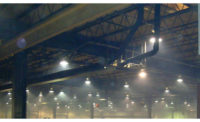EPA pollutants emission rule
Are your welding operations compliant?






Who the rule impacts
How do you know if your facility is using these materials? Consult the Material Safety Data Sheets (MSDS) for the base materials that you use — e.g. welding rod, welding wire, etc. A standard MSDS will list hazardous ingredients in Section 2 (Figure 1).
The rule applies to companies primarily engaged in one or more of the categories shown in Figure 2. Operations impacted by the rule cover eight processes: dry abrasive blasting (three types), dry grinding, dry polishing with machines, dry machining, spray painting (two types) — and last but not least, welding.
Exceptions include military installations; NASA facilities; national nuclear security facilities; military munitions facilities; research or laboratories as defined in the Clean Air Act; tool, quality control and equipment repair facilities; and welding facilities using less than 2000 lbs. of rod or wire.
Your facility is likely to be impacted if you: (a) are in one of the industry categories in Figure 2; (b) are primarily engaged in one of the processes identified above; (c) exhaust the air straight outdoors; and (d) fail an EPA Method 22 Fugitive Emission test.
Method 22, which is conducted to provide a visual determination of fugitive emissions from material sources, is performed by an observer with two stopwatches. The observer stands 15 feet or more from an exhaust stack with a clear view of the exhaust with the sun at his back and lines up a dark background. He starts the watch in his left hand and runs it continuously for 15 minutes. He starts the watch in his right hand when emissions are observed (opacity), and stops it when they are not. If opacity — defined as the quality of a particle that makes it impervious to light — is observed during 20 percent or more of the 15-minute test period — i.e., three minutes — Rule 6x applies.
Required actions
If Rule 6x applies and a company has failed the Method 22 test:
1. Notify the EPA.
2. “Tier 1” response: Change the process to eliminate the HAP. This might be accomplished by experimenting with different materials and/or different settings to reduce emissions. Whatever changes are made, equipment must always be operated in accordance with manufacturer’s instructions.
3. Conduct another Method 22 Emissions test.
4. “Tier 2” response: If the second test fails, “Corrective action must take place immediately after the failed Method 22 test” per the Federal Register, page 42985, Welding compliance, Tier 2.
The role of cartridge dust and fume collection
Some welding shops rely on standard HVAC filtration to clean the air, exhausting welding fumes out to the atmosphere in potential violation of the new EPA requirement. Still other facilities simply open the shop door when fumes build up inside, with the same result.
One corrective strategy that offers multiple benefits is the use of a dust and fume collector with high efficiency cartridge filtration. Cartridge filtration is identified in the regulation as an acceptable control device to eliminate visible emissions, and will in many cases be the solution of choice.
A well-designed cartridge system will properly filter welding fumes and other hazardous contaminants, and the filtered air can either be recirculated back into the facility or exhausted outside. These systems use self-cleaning mechanisms that pulse dirt off the filters, allowing units to run for extended periods between filter change-outs.
If air is exhausted outdoors, the EPA Rule 6x procedures will apply as above. Contact the EPA Regional Office (http://www.epa.gov/ttn/atw/area/regional_contacts.pdf) to find out which agency enforces this rule for a specific location. Under Method 22, the EPA requires ongoing annual compliance that is specific to the operation and is based on the date that the facility originally declares compliance.
If a company opts to recirculate the filtered air instead of exhausting it outside, the EPA NESHAP requirement no longer applies; but the indoor air must still comply with OSHA permissible exposure limits (PELs) (http://www.osha.gov/SLTC/pel/). The collector may also require safety monitoring filters (also called after-filters) for added filtration and backup protection. Figure 3 shows a recirculating cartridge dust collection system.
Air recirculation is the single best way to maximize return on investment with a dust collector. By recirculating heated or cooled air back through the plant instead of venting it outdoors, the cost to replace that conditioned air is eliminated. Many facilities report five- to six-figure annual energy savings as well as additional savings from earned utility rebates and incentives.
Whether or not a company opts for a recirculating system, a high efficiency dust and fume collector can greatly reduce or nearly eliminate employee exposure to welding chemicals. The result is a cleaner and greener work environment that safeguards employee health, comfort and morale, boosts productivity and enhances manufacturing reliability.
What kind of dust collection system is best for your application? Source capture systems that utilize flexible arms or hoods are popular for applications involving small parts and fixture welding. Ambient systems that filter all the air in the shop using a central system or multiple smaller collectors are sometimes chosen to serve larger areas because they allow a facility to vary its operations and still capture all the fumes. Booths or custom enclosures form a middle ground between the two by isolating a specific area for fume collection.
Ask the filtration manufacturer for a written guarantee that emissions, stated as grains per cubic foot, will be at or below thresholds required by the EPA or OSHA as applicable. For best results, also follow performance guidelines published by the American Conference of Governmental Industrial Hygienists (ACGIH).
Looking for a reprint of this article?
From high-res PDFs to custom plaques, order your copy today!









